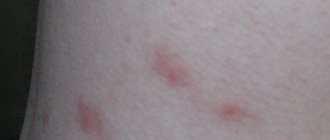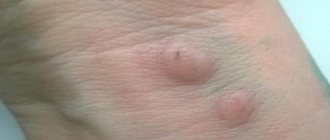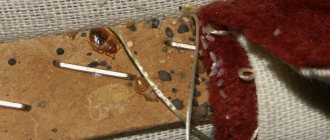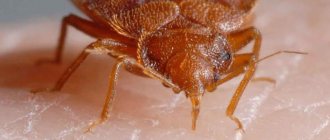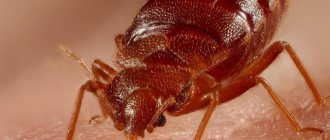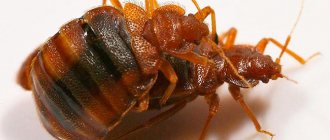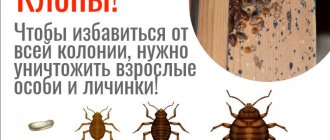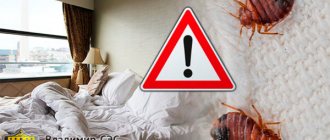Human blood is actually the only suitable food for bed bugs that live in the house. There is a widespread belief that bedbugs of this kind only grow in rooms with unsanitary conditions. But this is a mistaken opinion.
Quite often, these parasites take up residence in absolutely clean houses and apartments. If you notice red itchy bites on your body, then this is a reason to wonder whether your home has been attacked by these bloodsuckers. Read on to learn how to distinguish bedbug bites from mosquito bites and other insects and how to prevent the appearance of hated parasites in your home.
What do the bitten areas look like and where are they located?
Typically, bedbug bites appear as slightly raised spots on the skin that are red in color.
Defects appear only in those places that are free from clothing - on the arms (up to the shoulder), on the neck, on the legs, etc. Many, when they discover such damage on their body, attribute everything to mosquitoes, fleas, midges, and allergies. But there are a number of features of bedbug bites that make it possible to distinguish them from defects left by other insects. What does a bedbug bite look like :
- Usually the damaged area looks like a convex red spot with a small mound (bump) in the center.
- The severity of the bite varies, it all depends on the characteristics of the human body. Some get by with barely noticeable pink spots, while others suffer from huge crimson blisters that grow on the skin like an allergy and itch terribly.
- The degree of itching can also vary. Typically, symptoms manifest themselves most clearly in those who suffer from reduced immunity (children, elderly people).
- Upon careful examination of the damage, you can notice a mark from the pest’s proboscis at the very core of the bite. At first, the defects will not cause any obvious discomfort, since the parasites’ saliva contains anesthetic compounds. But after a while, the damage will begin to swell, hurt and itch.
- The greatest discomfort from bites will be felt where the skin is thinnest and most sensitive - on the neck, behind the ears, in the armpits.
Important! Not everyone is bitten by bedbugs. They pose the greatest danger to women and children, since they have more sensitive and thin skin (it is easiest to bite through and the smell of blood is felt more actively through it). So if in your home similar defects appear in certain family members, then this is a reason to suspect the presence of bed bugs.
Differences from traces of attacks by other parasites
Many people, getting out of bed in the morning and finding traces of insect bites on their body, first of all think about mosquitoes or midges. However, bedbug bites have their own characteristics that distinguish them from the damage left by other parasites:
- they appear in areas that were covered with a blanket at night;
- the damage is usually not single, they are located in the form of “tracks” consisting of 4–8 spots at a distance of 3–5 cm from each other;
- defects rarely appear on the face, since bedbugs, unlike midges or mosquitoes, do not like this part of the body;
- bites have clearer boundaries;
- the reaction to damage from these parasites appears within a few hours/days;
- itching from bites appears in the morning, immediately after a night's rest;
- damage can appear in the cold season, when most blood-sucking parasites are no longer active.
Komarov
The first thing that comes to mind after discovering red bites on the body is mosquitoes. It is these pests that most victims think of, because outwardly, bedbug bites are very similar to mosquito bites. However, mosquitoes are rarely able to damage the skin that remains under the blanket most of the night. In addition, these bloodsuckers do not leave “paths” of damage , are not able to get under clothes or a blanket, and in the cold season they are inactive.
Bloch
The marks left on the skin by fleas are even more reminiscent of bedbug bites than the marks left by mosquitoes. However, fleas are selective parasites - they prefer to bite a person in certain places: popliteal cavities, armpits, waist, etc. This is what distinguishes them from bed bloodsuckers.
Moshek
Midges prefer to carry out all their blood-sucking activities in the summer. These parasites bite people mainly on the street, preferring to attack exposed parts of the body, the scalp (they fly into the hair). They also often bite a person on the face, which is not typical for bed bugs.
A person can feel the moment of a bite; it is more painful and pronounced, since the saliva of midges does not contain an anesthetic substance that bed bugs have.
What does a bug bite look like?
Linen bug bites on the body are most often the first signs that uninvited tenants have entered the apartment.
In order to take timely measures to expel them, you need to learn to distinguish a wound on the body from a bug bite from an allergic reaction and bites of other insects.
The main signs of bedbug bites on the human body:
- Characteristic paths of 3–5 wounds at a distance of 1–1.5 cm between them.
- Near the hole in the center through which the parasite sucked blood, there is a slight swelling and a red spot with a clearly defined halo.
- Itching after waking up at the bite sites.
- Painful sensations when pressing on the swelling.
A clear sign that the bites on the body were caused by bedbugs can be small brown spots on the sheet. They remain from the blood that leaked from the puncture site made by the bug.
How many times does an insect usually bite?
During one feeding procedure, a bug can penetrate the skin 1–10 times. However, a single bite is very rare . Typically, parasites move in a straight line, leaving behind a string of identical defects. Damage in such a “path” is located at a short distance from each other. An adult requires large volumes of blood to be completely saturated, which is why one bite cannot do it all.
But nymph larvae are quite capable of biting through the skin only once. They don't need a lot of food yet, so they eat from one damage. Older larvae are more voracious and can make 2-3 bites in one feeding.
Only one larva can live on one bed, and its parents are always present nearby. So if you have a single damage, then it is most likely the mark of a mosquito or other insect, but not a bedbug.
How to avoid being bitten?
It is important to think not about what consequences may arise due to an insect bite, but about what to do to avoid them. Therefore, it is better to get rid of bed bugs in time so that you do not have to feel their presence in the house.
So, as a rule, the most common places where bedbugs stay are folds of clothing, crevices, and various objects. Even after returning from a trip, a person can bring home such an unpleasant gift in his pocket or suitcase. It should be taken into account that these parasites are tenacious; without food they can exist for about a year. That is why, if you have visited dubious places, when you come home, wash your clothes and all bedding in hot water. If the fabric of all these things allows, then it is even better to boil them.
Among the folk remedies for combating bed bugs, such as wormwood infusion, turpentine, kerosene, and green soap are known. But, unfortunately, such methods of fighting insects are not very effective. Therefore, it is better to entrust this matter to professionals and, with their help, disinfect the house. A distinctive feature of modern means is that they kill bedbugs, and do not repel them, like traditional ones. When the treatment is completed, you need to thoroughly vacuum the entire room to collect the eggs that the bloodsuckers managed to lay. Of those that remain in inaccessible places, young individuals will hatch, but they should die within a day from the action of pesticides.
Many people know that bedbug bites cause considerable discomfort. And if you decide not to turn to the help of specialists for now, but to fight insects with your own efforts, then there is another way to influence bedbugs. We are talking about low temperatures. What should be done? It is necessary to take out the furniture (if possible all) and books for 1.5-2 hours in twenty-degree frost. If bedbugs appear again, the procedure is repeated.
What places does it bite most often?
Most often, bed bug attacks occur on exposed areas of the skin. Although sometimes, in pursuit of food, bedbugs are ready to get under clothes .
These bloodsuckers prefer areas of the body with the most sensitive and delicate skin, since they are easiest to bite through and get to the blood, which means saturation in such places will be faster. The most vulnerable areas:
- inner surfaces of the hands;
- face;
- neck;
- groin area;
- stomach;
- legs (rarely).
The main differences between mosquito and bedbug bites
How to distinguish a mosquito bite from a bedbug bite? The question is somewhat complicated. It all depends on the conditions. For example, during the cold season there are no mosquitoes in houses. They prefer warm conditions, so their activity occurs in the summer season. Creatures that cannot fly do not react to temperature the same way. Even in a cold room they can easily attack residents.
The size and color of the lesion are no different. So relying on these parameters is useless!
If a mosquito is capable of biting a person at any time of the day, then the bug is pedantic in this regard. For his vampire hunt, he chooses exclusively late evening or night. However, there is one more thing worth reporting: when there is severe hunger, the arthropod becomes courageous. The parasite literally loses its fear and sets off headlong towards its visible victim. If a person is attentive, then the enemy who quickly paws at him comes to an end.
In addition, mosquitoes can bite through thin fabric: gauze, chintz and other materials. Bedbugs specialize only in exposed areas of the skin. Most of all they are impressed by necks, arms, legs, faces.
But it’s not just mosquitoes that can cause trouble, and now you know how bed bugs bite.
Who is most often attacked?
Bed bugs are quite selective parasites in terms of food. They are prone to strict selection of their “victims”. For example, if there are two people in bed, then only one of them will most likely find bite marks on their body.
Given a choice, parasites will most likely choose the person whose skin is the most delicate and thin. The thinner the layer of epidermis, the more clearly the smell of blood is felt (and it is much easier to bite through such skin).
Children and young women suffer most often from parasite attacks.
Men have rougher skin and are often covered with copious amounts of hair, and bed bugs do not like this at all. So their likelihood of being bitten is very low, but not zero.
Researchers studying the activities of bedbugs conducted an experiment. They decided to check which blood type these parasites prefer to use as food most often. The study found that for these insects there was no significant difference between the groups, although they were slightly more likely to select patients from the first group.
Those who prefer to wear maximally revealing clothes at home are also at risk. This makes it easier for bloodsuckers to reach delicate areas of the skin and bite through them. Of primary importance for parasites is only the amount of food and easy access to it.
Who is most often bitten by bedbugs?
When attacking people, bedbugs behave quite selectively. Of two people in bed, sometimes only one can find wounds on the body in the morning.
In such a situation, the question arises, which of the family members do bloodsuckers prefer?
- When given a choice, parasites choose victims with thin skin texture. The smaller the layer of epidermis, the more acutely the taste of blood is felt, and such tissue is easier to bite through.
- Children are the first to be attacked. Adults have much rougher skin. Women are in second place. Men take last place, but the chance of being bitten is not zero.
- Researchers interested in the preferences of bedbugs conducted a study to determine which blood type insects value more. It turned out that there is not much difference for bedbugs, but they prefer the first blood group.
- Bed bugs look for unprotected areas of the skin, because they are not able to attach themselves through clothing, so a victim with a minimum amount of clothing is selected.
We can conclude that for a bloodsucker it does not matter in principle who to bite. Gender and blood type do not affect the choice of victim. For them, only the necessary food and easy ways to obtain it are of paramount importance.
How dangerous is a bloodsucker attack for a person?
Of course, bed bug bites do not pose a serious danger to humans. However, the physical discomfort they cause can lead to unpleasant consequences. For example, constant itching that gives no rest can deprive you of sleep and prevent you from relaxing, so a nervous breakdown due to constantly itching bites is quite common.
Some people (especially women) who are afraid of insects, upon noticing such “neighbors” in bed, can reach the point of panic and even hysteria.
Possible consequences
People with rougher skin tolerate bedbug bites much more easily. The small wounds left on their body only itch slightly, so the defects resolve quite quickly and painlessly. But people with sensitive and delicate skin constantly scratch the damage , leading small wounds to the appearance of complications and abscesses.
There is a small percentage of people who are so susceptible to the bites of these parasites that they develop an allergic reaction to any damage caused by the bed bug. For such patients, encountering parasites poses a serious danger (they are at risk of developing edema and suffocation). An advanced allergy can result in anaphylactic shock.
Treatment with home remedies
What should you do initially if you find a bite on your body? If this phenomenon causes discomfort, you can initially take a sedative tablet. Sometimes massive bites drive a person to a hysterical state, especially when combined with unpleasant symptoms of itching and burning of the skin. Once you have calmed down, you can begin to treat the bites.
Treatment procedures should begin with washing the skin in warm running water (possibly with laundry soap), which will reduce the symptoms of itching and scabies. Next, you can use the following types of available tools:
Ice. After washing the bedbug bite area, apply a piece of ice or something cold to it. Ice will help relieve swelling and freeze the wound, which will speed up the healing process.
Table vinegar. You can treat itching with vinegar, which every housewife has in her arsenal. You need to moisten clean gauze or cloth with vinegar, and then rub the skin where it was damaged by insects.
Black or green tea. It is necessary to brew black or green tea as strong as possible, then soak gauze in it and apply it to the site of the bug bite. Such compresses help relieve swelling and relieve symptoms of itching.
Medical alcohol. Surely everyone has a bottle of ethyl alcohol in their first aid kit, which needs to be used to treat the affected areas of the body. A one-time treatment of the skin is enough to avoid infection from entering the wound. When using alcohol, signs of burning may be felt, which is normal.
Tincture of calendula or propolis. Wounds can be treated with tinctures of medicinal herbs, but be careful, as symptoms of burning skin are possible.
Soda solution. If there is no alcohol in the kitchen, then soda can be used. First you need to prepare a soda solution, which you can use to moisten the affected areas of the skin 2 times a day.
This is a list of the main ways by which you can quickly and effectively get rid of unpleasant symptoms after a bedbug bite.
How does it manifest in a child?
Bed bug bites in children usually do not look particularly serious : they develop redness or blisters on the body, which quickly resolve if they are not scratched.
If the infection has not been introduced, then the itching will quickly subside, the spots will disappear, and the child will not feel any serious discomfort. But if your child’s body is overly susceptible to attacks by parasites, then the following complications cannot be ruled out:
- inflammation of the lymph nodes;
- the appearance of allergic reactions;
- a sharp increase in temperature;
- severe headaches;
- indigestion;
- infection of damaged skin.
All of the above symptoms are very rare. Typically, the most severe discomfort felt from bed bug bites is psychological. The child cannot sleep normally, he constantly wakes up, does not rest, and because of this he begins to be capricious and irritated. So his parents will be forced to share the full burden of his situation.
The difference between bedbug bites and an allergic reaction
In most cases, bedbug bites are misdiagnosed as scabies or an allergy to something. But there are significant differences between a bedbug bite and an allergic reaction.
- The redness from the bite is not continuous, it is located in a path.
- The allergic rash is spread over the entire surface of the body, and not in any individual open areas.
- The bite mark, as a rule, does not change over time; the size, color and shape of the allergy rash can change quite quickly.
- Other family members did not notice anything suspicious on their skin, unlike the victim.
How to treat?
Typically, such injuries do not require any special treatment. But if the itching has become unbearable for you, and you cannot put up with it, then you can try using the following remedies:
- Tar or toilet soap needs to be thoroughly foamed, and then lubricated with the resulting foam on the inflamed defects and wait until the product dries. As soon as the itching subsides, rinse off the soap with cool water.
- Rub regular unscented baby cream onto the bites. This will help reduce the desire to scratch the damaged area of skin.
- Various essential oils, as well as “Zvezdochka” balm, are excellent for treating severe itching. Just lubricate the blisters with it, being careful not to scratch the treated areas.
- If constant scratching has caused an infection in the wound and an abscess has formed in its place, then use special pharmaceutical products that will help eliminate purulent inflammation at home. If you develop a serious abscess, it is better to immediately consult a specialist and not self-medicate.
How long does it take for wounds to heal?
The healing period for damage left by bedbugs depends on the susceptibility of the body. Most often, the defects disappear within a few hours , but if the immune system is weakened, then healing can take a day.
In rare cases, the patient may suffer from an allergic reaction to parasite bites. In such situations, healing of wounds and reduction of itching can take a week, or even a week and a half.
Why do bitten areas itch?
Itching after bedbug bites occurs due to the fact that the human immune system fights the defect.
When the parasite pierces human skin, it launches its special proboscis into the wound, which is divided into two tubules. From one channel, an anesthetic secretion enters the wound, which prevents the “victim” from noticing the attack, and with the help of the second channel, the insect sucks out the blood. After some time, the immune system begins to fight the damage, so that the skin becomes inflamed and severely itchy. In some cases, an allergic reaction to bedbug bites develops (more precisely, to that same anesthetic secretion), so increased itching is inevitable.
Whom do parasites attack most often?
According to statistics, women are more often victims of these insects. If we talk about which blood type bedbugs prefer, then statistics show that carriers of the first and second groups suffer most from these parasites, while the size of the bite does not change. Pests allegedly attack people with the fourth or third blood group less often.
Why don't all people get bitten? The answer is actually quite simple. In fact, bedbugs react equally to people with any blood type, but the first and second are more common than the third and fourth, which is why there are more cases of complaints about parasites from such people. The situation is the same with attacks on men and women: in fact, insects drink blood from representatives of both sexes, but women more often notice bites almost immediately and turn to specialists.
Important: it should be noted that the number of marks on a person’s body directly depends only on the level of pest infestation of the home. If it is quite low, several dozen fresh spots will appear on the body overnight. If, on the contrary, it is high, a person will find up to 500 fresh bites on his body every morning in different places.
Do bed bloodsuckers hunt during the day?
Bedbugs are nocturnal parasites . They obtain food for themselves exclusively at night. During the daytime, they scatter around their hiding places - hiding in furniture, behind baseboards, in cracks and crevices in the floor or walls and other secluded corners of the house.
Only a very strong and prolonged hunger can force a parasite to carry out a daytime attack on a victim (for example, the residents of an apartment left their home for a long time and left, and returned after some time). But such cases are rare.
What should I do and what should I apply to prevent bedbugs from biting me?
Dead bug
Insect bites can be prevented if you carry out thorough preventive procedures, which determine the likelihood of infection.
First of all, you should protect your own body. You need to know that bedbugs do not like odors containing alcohol additives. Therefore, you can safely use colognes or perfumes. You should lubricate different parts of the body with these products. Their aroma will only drive away insects. This procedure should be carried out before bedtime, since bedbugs bite mostly at night.
Instead of perfume, you can use essential oils, and also lubricate exposed areas of the body with fish oil. A composition prepared from a decoction of edible cloves with cologne in equal proportions will be no less effective. The resulting mixture must be applied to the body again before bed. Repellents are also allowed to lubricate the skin for preventive purposes.
Along with procedures aimed at completely protecting the body from bedbug bites, it is very important to apply a smear on bedbug bites; you need to purchase a specialized product designed to treat the room and objects in it. To do this you will need an insecticide, which is applied:
- on internal parts, back walls of furniture,
- on the underside of the mattress,
- on the cracks between the baseboard and the wall,
- on the back side of rugs, carpets, paintings,
- in places where the trellises recede.
Bed linen, including pillows and blankets, must be washed at a fairly high temperature. A good remedy in such a situation would be wormwood, which can be spread on the floor under the beds, tables, and chairs. It also drives bedbugs away from the premises. Mashenka's chalk is a great help in the fight against bedbugs.
Do they show interest in pets?
The main source of food for bed parasites is humans . If a person is absent from the house for a long time, but pets remain in it, then bedbugs may well feast on their blood. But this will only happen if people have been absent for a long period of time, and insects are tormented by severe hunger. In this case, cats or dogs may be attacked.
Under normal conditions, these parasites do not associate with domestic animals, since their bodies are covered with thick and dense hair, through which it is very difficult for the insect to reach the skin.
What are bed bugs?
No person is immune from an infestation of bed bugs. If you live in a high-rise building and your neighbors have parasites, be prepared for them to come to you.
Insects crawl through door cracks, cracks in walls, ventilation systems and electrical wiring. In the warm season, they reach people from the outside of the house.
The main source of food for bedbugs is human blood. In case of unbearable hunger and lack of food, they can attack animals. But most often, bedbugs get into the house from the street, clinging to the fur of pets. In one night, parasites are capable of inflicting up to 500 bites, as they live in groups.
Bedbugs feed using a special organ - the proboscis, consisting of two jaws. With one they inject saliva containing an anesthetic into the human blood, and with the other they pierce the human skin.
Due to the anesthetic contained in the saliva of bedbugs, a person does not always feel the bites. Bedbugs operate mainly at night or early in the morning, when the victim is sleeping.
How to protect yourself?
If you do not have the opportunity to remove all blood-sucking parasites from your home as soon as possible, then you can temporarily protect yourself and your loved ones from night attacks. Here are some tips to help scare away the hated pest:
- These insects cannot tolerate formulations that contain alcohol. So apply cologne, lotion or perfume to your body before bed. This will help you get a good night's sleep.
- Essential oils also work well to repel pests. Apply them to exposed areas of the body.
- You can also use fish oil; it also repels bed bugs very well.
- A homemade decoction of food cloves and cologne works well against bed bloodsuckers. Apply this mixture to exposed areas of skin that are not covered with blankets or clothing.
But all these measures are temporary. Bed bugs multiply very quickly , so in a short time they can fill the entire apartment and not give you rest either at night or during the day. If you notice the first signs of these pests in your home, seek help from a professional pest control service as soon as possible. The sooner you start fighting these harmful insects, the easier it will be for you to completely get rid of them.
Bed bugs that have settled in an apartment or house can become a real problem for residents. These parasites feed on human blood, leaving itchy blisters on the human body after their “incursions.” Constant itching, inflammation and the inability to fully rest at night really drives you crazy, so don’t hesitate to contact an experienced exterminator.
You can get rid of pests in your home once and for all only with the help of experienced specialists.
When do they bite most often?
As a rule, fresh bites of domestic bugs on the human body appear from 3 to 7 am. At other times of the day, bedbugs are less likely to attack humans. If the home is heavily infested with these parasites, the bites will not stop during the daytime. This fact indicates the need for professional pest control in the apartment.
How often do these parasites bite? The activity of these insects depends little on the level of illumination in the room. For these parasites, light is a deterrent, but rather weak. If in the first days it reduces the activity of insects, then after a few days they get used to the new conditions and practically do not react to it.
Important: it should be noted that the frequency of bites from these parasites usually increases when larvae appear in their colonies. Why is this happening? The fact is that the larvae themselves are forced to feed on human blood every day (usually an adult does this once every few days). Accordingly, the number of wounds on the body during the period of their appearance will increase significantly.

